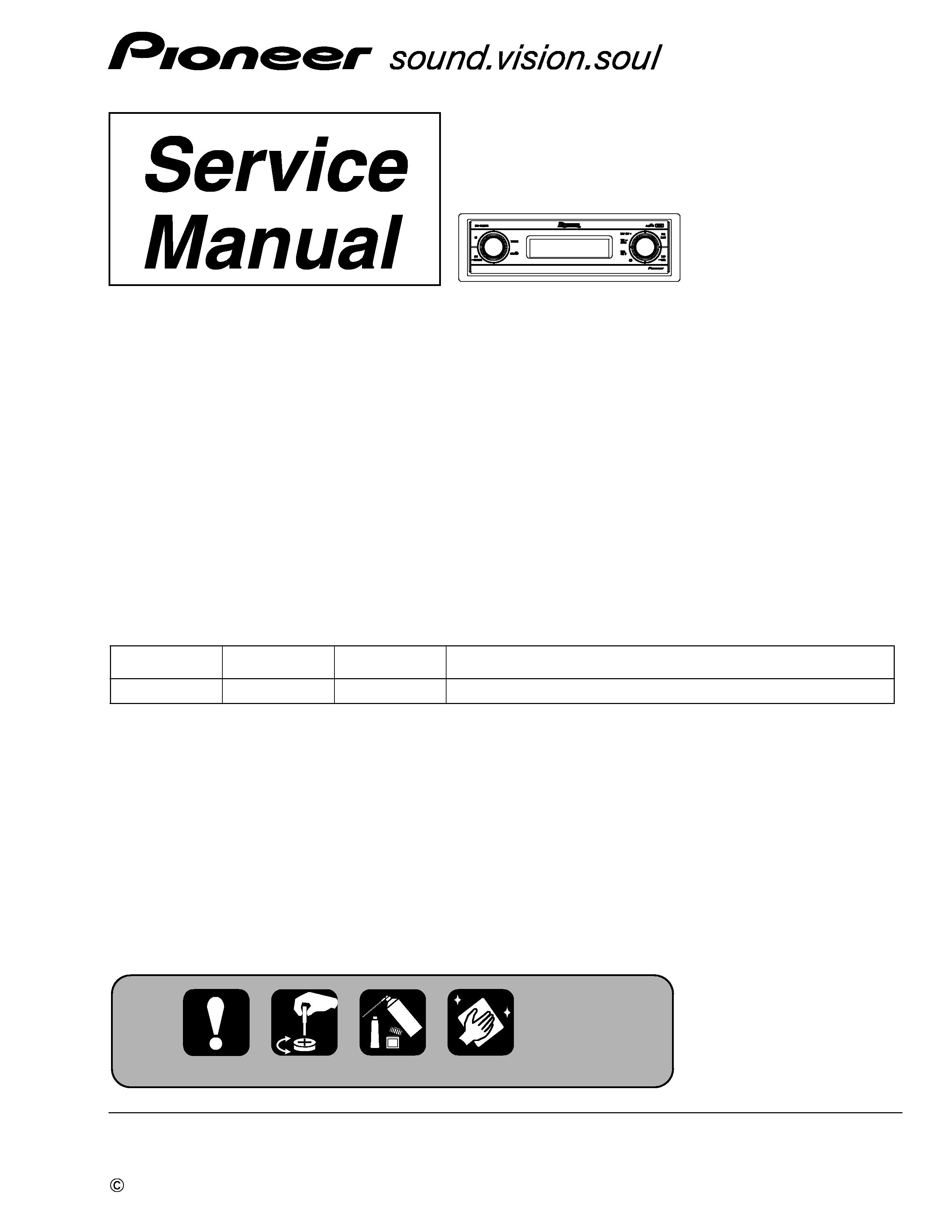
ORDER NO.
PIONEER CORPORATION 4-1, Meguro 1-chome, Meguro-ku, Tokyo 153-8654, Japan
PIONEER ELECTRONICS (USA) INC. P.O. Box 1760, Long Beach, CA 90801-1760, U.S.A.
PIONEER EUROPE NV Haven 1087, Keetberglaan 1, 9120 Melsele, Belgium
PIONEER ELECTRONICS ASIACENTRE PTE. LTD. 253 Alexandra Road, #04-01, Singapore 159936
PIONEER CORPORATION 2006
DEH-P880PRS/XN/UC
CRT3650
MULTI-CD CONTROL HIGH POWER CD/MP3/WMA/AAC PLAYER WITH FM/AM TUNER
DEH-P880PRS
/XN/UC
DEH-P80RS/XN/ES
MULTI-CD CONTROL DSP HIGH POWER CD/MP3/WMA/AAC PLAYER WITH RDS TUNER
DEH-P88RS/XN/EW5
This service manual should be used together with the following manual(s):
Model No.
Order No.
Mech.Module
Remarks
CX-3164
CRT3583
S10.5COMP1
CD Mech. Module : Circuit Descriptions, Mech. Descriptions, Disassembly
For details, refer to "Important Check Points for Good Servicing".
Z-ZZW. MAR. 2006 Printed in Japan
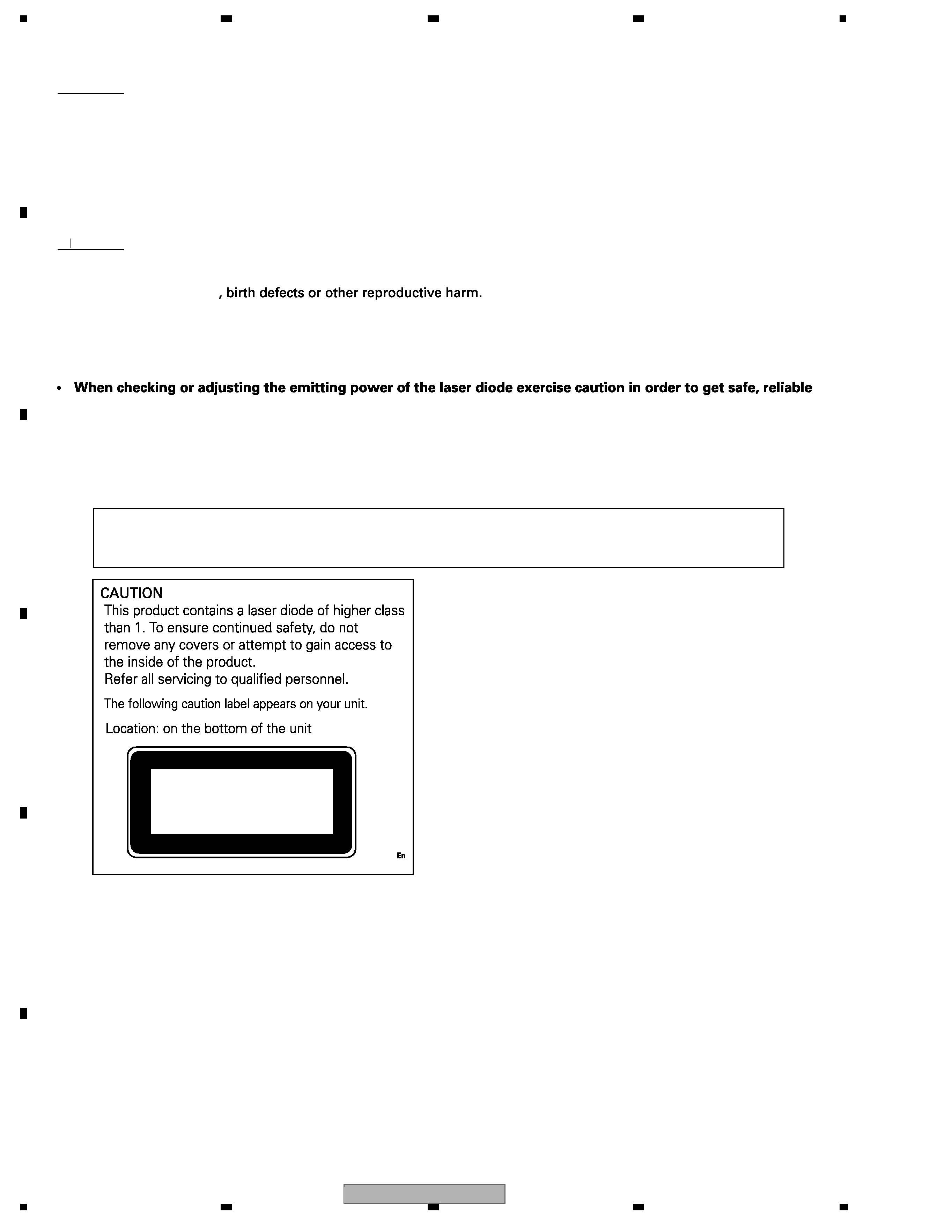
DEH-P880PRS/XN/UC
2
12
34
12
3
4
C
D
F
A
B
E
SAFETY INFORMATION
This service manual is intended for qualified service technicians; it is not meant for the casual do-it-yourselfer.
Qualified technicians have the necessary test equipment and tools, and have been trained to properly and safely
repair complex products such as those covered by this manual.
Improperly performed repairs can adversely affect the safety and reliability of the product and may void the warranty.
If you are not qualified to perform the repair of this product properly and safely, you should not risk trying to do so
and refer the repair to a qualified service technician.
- Safety Precautions for those who Service this Unit.
results.
Caution:
1. During repair or tests, minimum distance of 13cm from the focus lens must be kept.
2. During repair or tests, do not view laser beam for 10 seconds or longer.
WARNING
W
W
This product contains lead in solder and certain electrical parts contain chemicals which are known to the state of
California to cause cancer
Health & Safety Code Section 25249.6 - Proposition 65
CAUTION:
USE OF CONTROLS OR ADJUSTMENTS OR PERFORMANCE OF PROCEDURES OTHER THAN THOSE
SPECIFIED HEREIN MAY RESULT IN HAZARDOUS RADIATION EXPOSURE.
CLASS 1
LASER PRODUCT
CAUTION
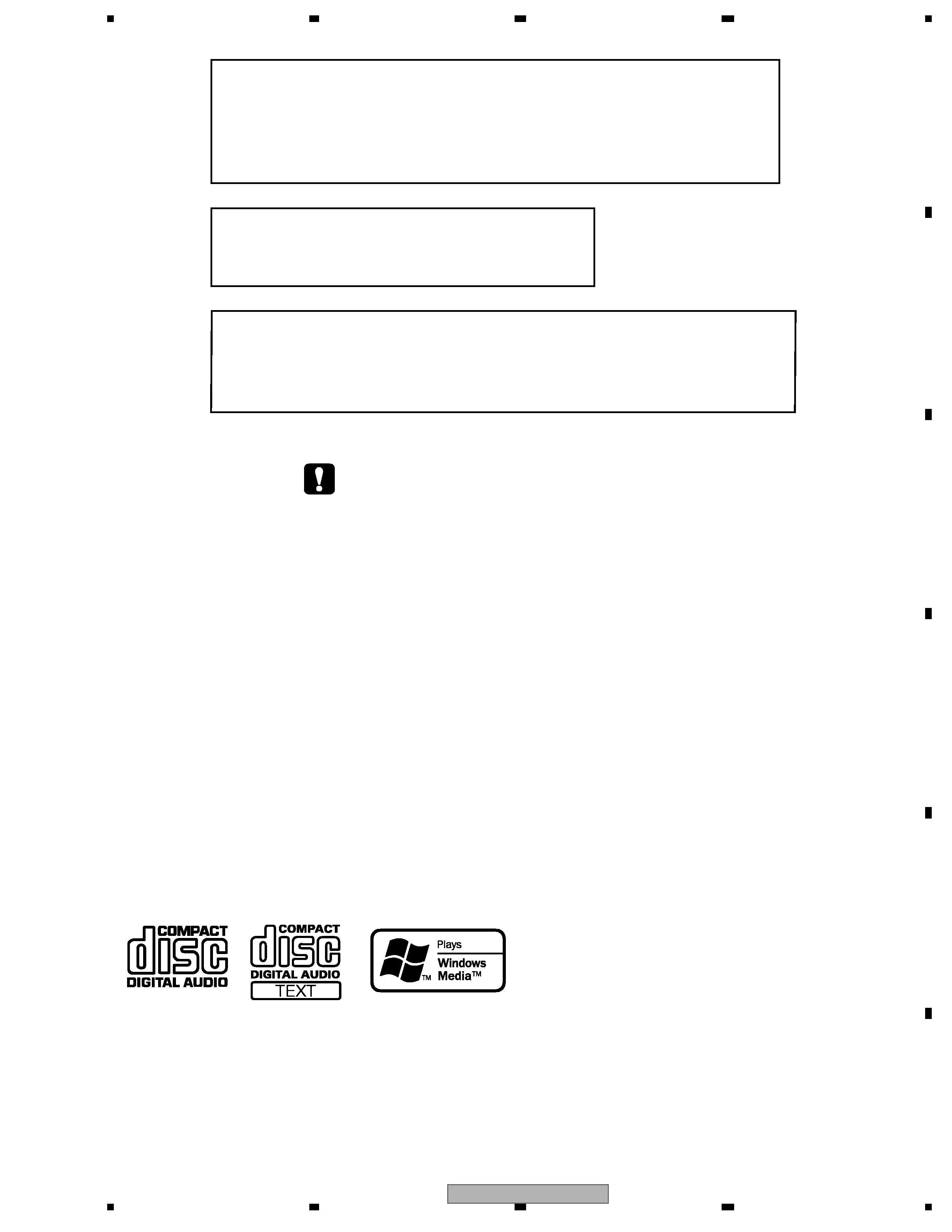
DEH-P880PRS/XN/UC
3
56
7
8
56
7
8
C
D
F
A
B
E
- CD Section Precaution
1. Before disassembling the unit, be sure to turn off the power. Unplugging and plugging the connectors
during power-on mode may damage the ICs inside the unit.
2. To protect the pickup unit from electrostatic discharge during servicing, take an appropriate treatment
(shorting-solder) by referring to "the DISASSEMBLY".
3. After replacing the pickup unit, be sure to check the grating.
- Service Precautions
1. You should conform to the regulations governing the product (safety, radio and noise, and other
regulations), and should keep the safety during servicing by following the safety instructions
described in this manual.
2. This product memorizes every audio setting value during operating product such as VOL position and
EQ setting. As the setting value is recorded in the built-in EEPROM, it does not return to the initial setting
value even if you press RESET key.
If you return it to the initial setting value, execute the Audio Reset in the initial setting menu.
However, if you execute it, the user setting is deleted.
If you change the audio setting when repairing the product, the product is returned to the user with that
setting, so take care of it.
Method of Audio Reset
After pressing MULTI-CONTROL key for two seconds, select Audio Reset by right and left rotation.
After shifting to the reset confirmation screen by right-pressing MULTI-CONTROL key and execute the
reset by center-pressing.
WARNING!
The AEL (accessible emission level )of the laser power output is less than CLASS 1
but the laser component is capable of emitting radiation exceeding the limit for
CLASS 1.
A specially instructed person should do servicing operation of the apparatus.
Laser diode characteristics
Wave length : 785~814nm
Maximum output : 1190
µW(Emitting period : unlimited)
Additional Laser Caution
Transistors Q101 in PCB drive the laser diodes.
When Q101 is shorted between their terminals, the laser diodes will radiate beam.
If the top cover is removed with no disc loaded while such short-circuit is continued,
the naked eyes may be exposed to the laser beam.
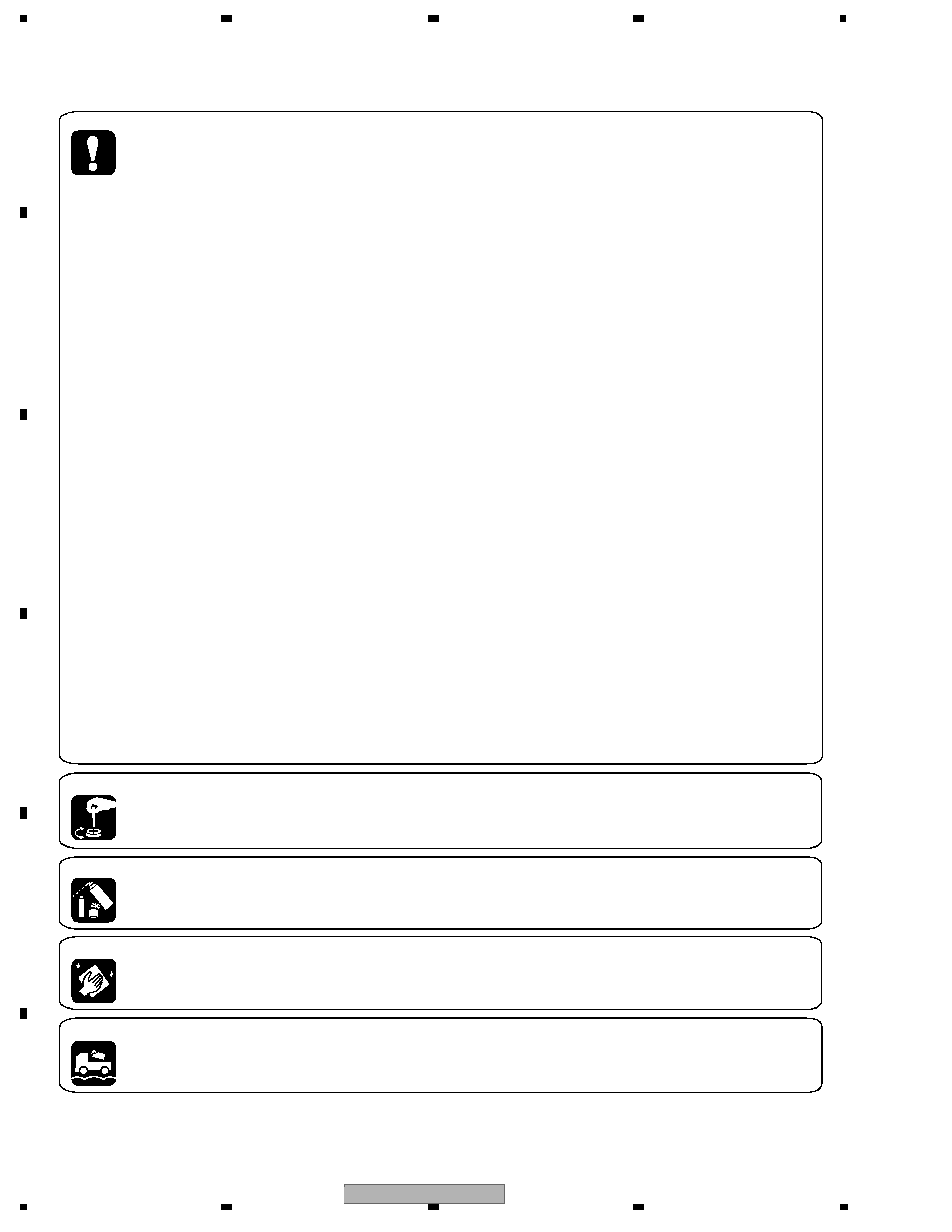
DEH-P880PRS/XN/UC
4
12
34
12
3
4
C
D
F
A
B
E
[Important Check Points for Good Servicing]
In this manual, procedures that must be performed during repairs are marked with the below symbol.
Please be sure to confirm and follow these procedures.
1. Product safety
Please conform to product regulations (such as safety and radiation regulations), and maintain a safe servicing environment by
following the safety instructions described in this manual.
1 Use specified parts for repair.
Use genuine parts. Be sure to use important parts for safety.
2 Do not perform modifications without proper instructions.
Please follow the specified safety methods when modification(addition/change of parts) is required due to interferences such as
radio/TV interference and foreign noise.
3 Make sure the soldering of repaired locations is properly performed.
When you solder while repairing, please be sure that there are no cold solder and other debris.
Soldering should be finished with the proper quantity. (Refer to the example)
4 Make sure the screws are tightly fastened.
Please be sure that all screws are fastened, and that there are no loose screws.
5 Make sure each connectors are correctly inserted.
Please be sure that all connectors are inserted, and that there are no imperfect insertion.
6 Make sure the wiring cables are set to their original state.
Please replace the wiring and cables to the original state after repairs.
In addition, be sure that there are no pinched wires, etc.
7 Make sure screws and soldering scraps do not remain inside the product.
Please check that neither solder debris nor screws remain inside the product.
8 There should be no semi-broken wires, scratches, melting, etc. on the coating of the power cord.
Damaged power cords may lead to fire accidents, so please be sure that there are no damages.
If you find a damaged power cord, please exchange it with a suitable one.
9 There should be no spark traces or similar marks on the power plug.
When spark traces or similar marks are found on the power supply plug, please check the connection and advise on secure
connections and suitable usage. Please exchange the power cord if necessary.
0 Safe environment should be secured during servicing.
When you perform repairs, please pay attention to static electricity, furniture, household articles, etc. in order to prevent injuries.
Please pay attention to your surroundings and repair safely.
2. Adjustments
To keep the original performance of the products, optimum adjustments and confirmation of characteristics within specification.
Adjustments should be performed in accordance with the procedures/instructions described in this manual.
4. Cleaning
For parts that require cleaning, such as optical pickups, tape deck heads, lenses and mirrors used in projection monitors, proper
cleaning should be performed to restore their performances.
3. Lubricants, Glues, and Replacement parts
Use grease and adhesives that are equal to the specified substance.
Make sure the proper amount is applied.
5. Shipping mode and Shipping screws
To protect products from damages or failures during transit, the shipping mode should be set or the shipping screws should be
installed before shipment. Please be sure to follow this method especially if it is specified in this manual.
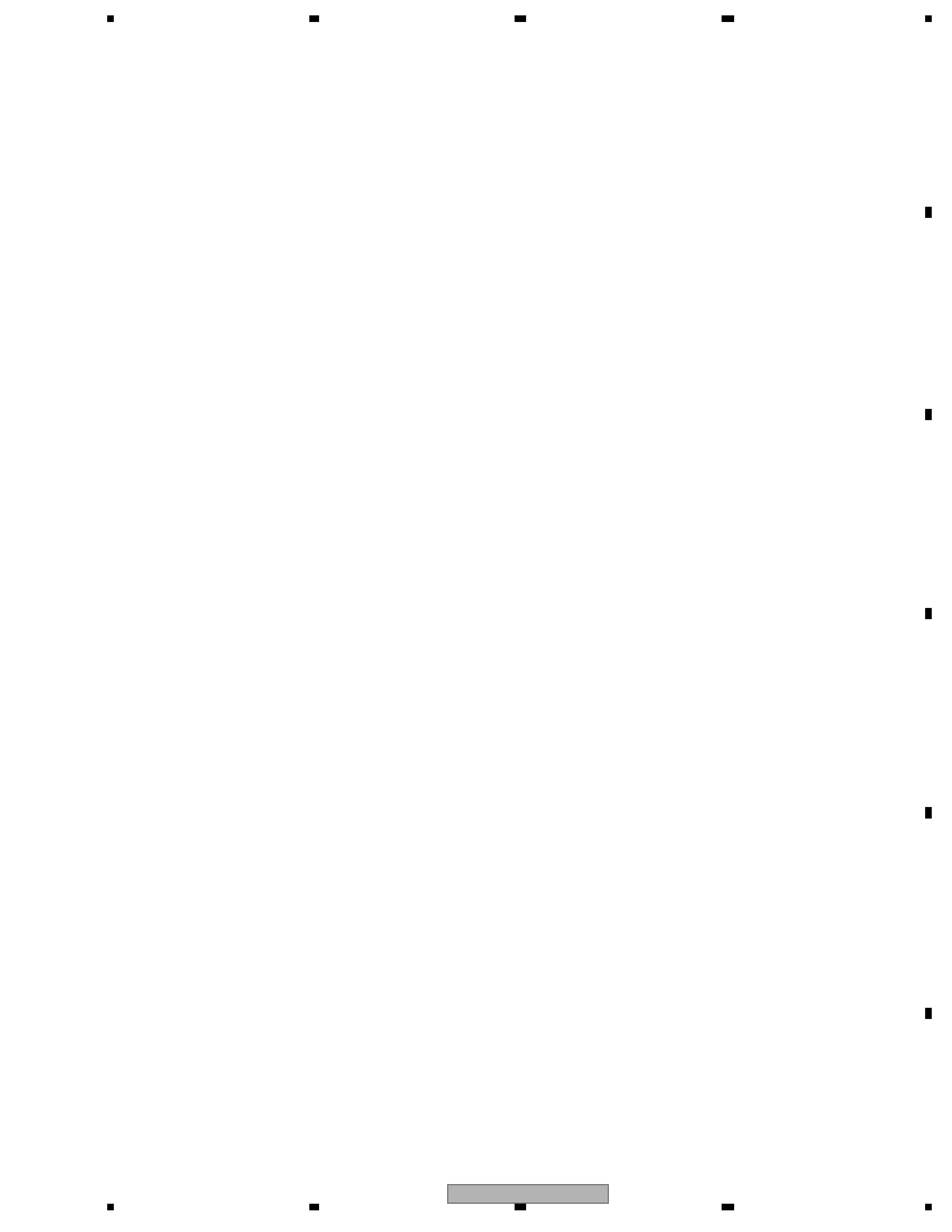
DEH-P880PRS/XN/UC
5
56
7
8
56
7
8
C
D
F
A
B
E
CONTENTS
SAFETY INFORMATION......................................................................................................................................2
1. SPECIFICATIONS .............................................................................................................................................6
2. EXPLODED VIEWS AND PARTS LIST...........................................................................................................12
2.1 PACKING(UC, ES MODEL) ......................................................................................................................12
2.2 PACKING(EW5 MODEL) ..........................................................................................................................14
2.3 EXTERIOR(1)(UC, ES MODEL) ...............................................................................................................16
2.4 EXTERIOR(1)(EW5 MODEL) ...................................................................................................................18
2.5 EXTERIOR(2) ...........................................................................................................................................20
2.6 CD MECHANISM MODULE .....................................................................................................................22
3. BLOCK DIAGRAM AND SCHEMATIC DIAGRAM ..........................................................................................24
3.1 BLOCK DIAGRAM ....................................................................................................................................24
3.2 OVERALL CONNECTION DIAGRAM(UC, ES MODEL)(GUIDE PAGE) ..................................................28
3.3 OVERALL CONNECTION DIAGRAM(EW5 MODEL)(GUIDE PAGE) ......................................................34
3.4 KEYBOARD UNIT ....................................................................................................................................40
3.5 CD MECHANISM MODULE(GUIDE PAGE) .............................................................................................42
4. PCB CONNECTION DIAGRAM ......................................................................................................................52
4.1 TUNER AMP UNIT ...................................................................................................................................52
4.2 KEYBOARD UNIT ....................................................................................................................................56
4.3 CD CORE UNIT(S10.5COMP1) ...............................................................................................................58
4.4 SWITCH UNIT ..........................................................................................................................................60
5. ELECTRICAL PARTS LIST .............................................................................................................................61
6. ADJUSTMENT ................................................................................................................................................76
6.1 OEL ADJUSTMENT .................................................................................................................................76
6.2 CD ADJUSTMENT ...................................................................................................................................77
6.3 CHECKING THE GRATING AFTER CHANGING THE PICKUP UNIT.....................................................79
6.4 ERROR MODE .........................................................................................................................................81
6.5 E.VOL IC OSCILLATING FREQUENCY ADJUSTMENT..........................................................................82
6.6 SYSTEM MICROCOMPUTER TEST PROGRAM ....................................................................................82
7. GENERAL INFORMATION .............................................................................................................................83
7.1 DIAGNOSIS ..............................................................................................................................................83
7.1.1 DISASSEMBLY......................................................................................................................................83
7.1.2 CONNECTOR FUNCTION DESCRIPTION ..........................................................................................87
7.2 IC ..............................................................................................................................................................88
7.3 OPERATIONAL FLOW CHART ..............................................................................................................103
8. OPERATIONS ...............................................................................................................................................104
